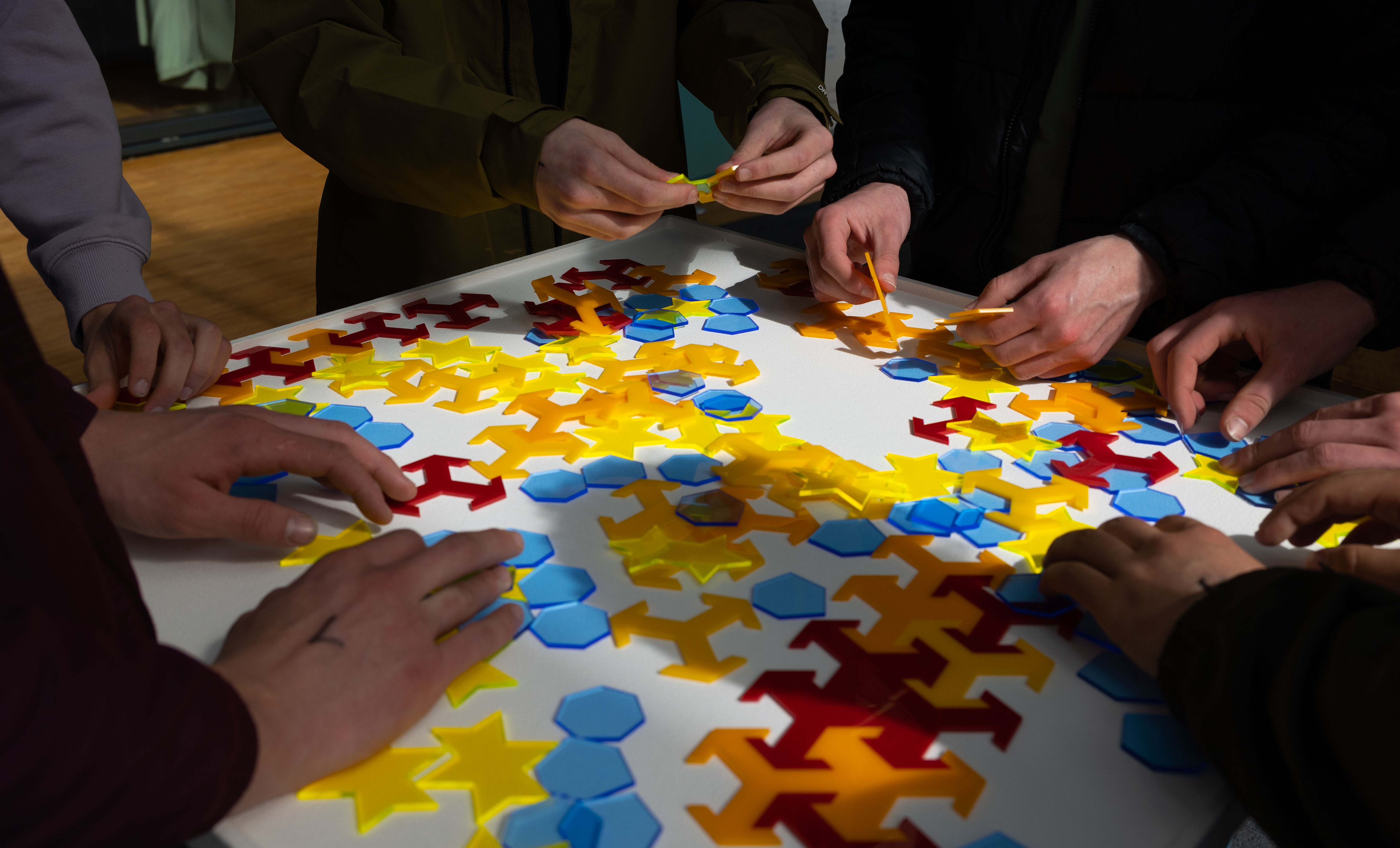Students visit IMAGINARY
The temporary exhibition IMAGINARY, about the beauty of mathematics, can be seen in the Bernoulliborg and the Energy Academy during the month of April. On Tuesday, April 4, about one hundred VWO4 students from different secondary schools in the northern Netherlands visited the Zernike campus, where they received two guest lectures on Astronomy and Chemistry in the morning. After lunch, they actively participated in workshops in smaller groups and were given a tour of the interactive IMAGINARY exhibition by a student assistant.
The part in the Bernoulliborg consists of mathematical posters, interactive screens, and challenging puzzles. The interactive parts attract the most attention from the students. Two boys are playing a game on a touchscreen where they map the ocean floor with boats. By working together, they find the treasure at the deepest point of the sea. "Well played," the boys say to each other as they shake hands.
"We don't remember exactly how we did it, but we could do it in 29 moves before."
One of the mathematical puzzles, "The Tower of Ionah," aims to move five discs of different sizes based on two rules: you can only move one disc at a time, and a larger disc cannot be placed on a smaller disc. The students say they solved the puzzle in just 29 moves. According to the caption, only real champions can perform the task in just 31 moves, so 29 is an impressive achievement. They try it again for the reporter. They remember the beginning of their strategy, but their brains almost fry when they reach the middle discs. "Should this one go on top?" says a boy. They get stuck, and after several attempts, they give up. "We don't remember exactly how we did it, but we could do it in 29 moves before."

"You really have to pay attention and not accidentally do something else."

After fifteen minutes, the group walks to the other part of the IMAGINARY exhibition in the Energy Academy. Students are interested in the mathematical 3D shapes and design their own algebraic surfaces with an interactive app. At picnic tables, students work in groups on cryptographic assignments. They concentrate on deciphering one of the secret codes, a so-called pigpen cipher. They find the solution: "Frikandelbroodje one plus one free." A girl remarks, "You really have to pay attention and not accidentally do something else."
Tjaarda found the Astronomy guest lecture interesting but would have liked to go deeper into the material. "The lecture was mainly about things I already knew," she says. The student comes from Friesland and is considering studying in Groningen. "I find law school interesting because my mother also studied it," she says. Psychology and medicine are also options for her.

Folding paper airplanes
As a final activity, the students receive a workshop on folding paper airplanes by professor and engineer Roel Luppes. He demonstrates the Bernoulli principle - named after the famous Groningen scholar - using a blank A4 sheet. "I blow over it, and as you can see, the paper goes up. How is that possible?" Luppes asks aloud. The Bernoulli principle explains that the speed of the airflow above the paper is higher than the speed below it, causing the pressure above the paper to be lower than under the paper. This creates a difference in pressure, causing the paper to go up. Luppes asks the audience, "Have you ever been in the shower while the shower curtain sticks to you? That is also explained by the Bernoulli principle because there is a faster airflow between you and the shower curtain than at the back of the curtain." Luppes further explains how this principle is used in aerodynamics when building an airplane.

Emergency landing
After the explanation, the students eagerly start folding paper airplanes and get to throw them into the lecture hall from the top of the stairs. "Let's give it a try," says a boy. He throws his first design into the room, but the flight is short-lived, and the airplane quickly dives towards the ground. His second airplane stays in the air for about five seconds and covers a fair distance. "Why is the second one better?" Luppes asks the student. The boy replies, "Because of the wing surface area, it's larger." One airplane makes an emergency landing against the ceiling and gets stuck against the lamp – it will stay there for a while.

The IMAGINARY exhibition is organized by Platform Mathematics Netherlands in collaboration with Dutch universities and supported by partner organizations and travels throughout the Netherlands. The Groningen edition is made possible in part by Science LinX, the science center of the Faculty of Science & Engineering. For more information, visit the IMAGINARY website.
Text: Myrna Kooij
Images: Leoni von Ristok
| Last modified: | 07 February 2025 12.33 p.m. |
More news
-
24 March 2025
UG 28th in World's Most International Universities 2025 rankings
The University of Groningen has been ranked 28th in the World's Most International Universities 2025 by Times Higher Education. With this, the UG leaves behind institutions such as MIT and Harvard. The 28th place marks an increase of five places: in...
-
05 March 2025
Women in Science
The UG celebrates International Women’s Day with a special photo series: Women in Science.
-
16 December 2024
Jouke de Vries: ‘The University will have to be flexible’
2024 was a festive year for the University of Groningen. In this podcast, Jouke de Vries, the chair of the Executive Board, looks back.
